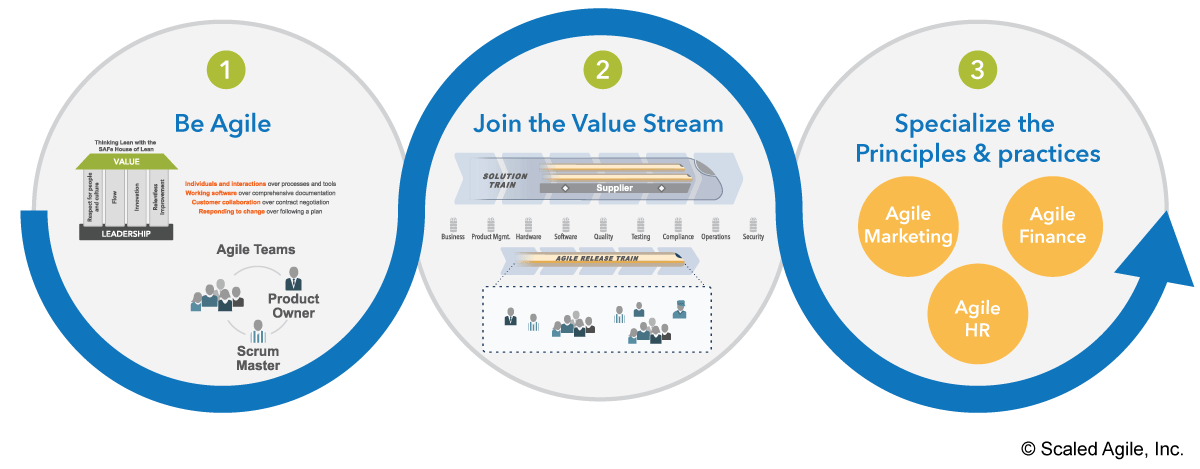Seeking Real World Business Agility
You’ve probably heard the term “business agility” thrown around a lot in recent years. It’s becoming one of those catchphrases that everyone knows is important, most think they understand, but few agree on what it actually means.
In fact, a simple Google search brings up hundreds of different definitions of the term, many of which are published on trustworthy sources of information about agile or general business topics with a combined readership that’s probably in the millions. Most of them are in the same ballpark, but there are nuances that become pretty significant as organizations try to actually pursue this increasingly nebulous goal.
It’s reminiscent of the term “DevOps” several years ago: everyone was using it, but no one could agree on what it actually meant. And, as time has passed, the importance of DevOps has only increased. Fortunately, time brings clarity, and most organizations that are serious about agile today have already obtained a clear understanding of what DevOps actually is.
The same needs to happen today with “business agility”.
Why Business Agility is So Important Right Now
Companies are dropping out of the S&P 500 faster than ever before. Many experts agree that “at the current churn rate, 75% of current S&P 500 companies will be replaced by 2027.” What’s behind this max exodus? It’s certainly not voluntary.
It’s happening because the rate of change in business is far faster than the rate of change within organizations, especially the big ones. As a result, large and old enterprises are losing market share hand-over-fist to younger, smaller companies that are quicker to adapt to change.
These more agile organizations enjoy tremendous advantages. For example, research by MIT Sloan found that “agile firms grow revenue 37% faster and generate 30% higher profits” than their more traditionally-run counterparts. That brings us back to business agility — not just the general concept of organizations that can change more quickly, but a specific set of skills and practices that can guide any organization to achieve that ideal.
What is Business Agility, Really?
After a lot of research and comparison, we’re settling on the definition offered by the Scaled Agile Framework (SAFe) in their newly released SAFe 5.0:
“Business Agility is the ability to compete and thrive in the digital age by quickly responding to market changes and emerging opportunities with innovative, digitally-enabled business solutions.”
Let’s break it down a little bit. They start with the basic concept that a lot of people use to define business agility, but then another dimension is added — and it’s huge:
- The ability to compete through change and innovation
- The holistic application of lean and agile principles and practices across all business units.
It’s that second half of the definition that offers a concrete pathway toward achieving the more general first half. And, that’s where most organizations that want to develop business agility fall short: in the execution. This pathway involves seven “core competencies” that form the throughlines tying the organization together and keeping it agile no matter how large it gets. And, it keeps the customer at the center of every decision made and action taken.
Those core competencies are:
- Enterprise Solution Delivery
- Agile Product Delivery
- Team and Technical Agility
- Lean Portfolio Management
- Organizational Agility
- Continuous Learning Culture
- Lean-Agile Leadership
The updated SAFe 5.0 framework has business agility at its very core. It’s the highest aspiration any company can achieve by successfully scaling their agile practices. And, with this new framework in place, that goal has become a lot more achievable.
One of the most important updates in SAFe 5.0, and key to achieving true business agility, is the inclusion of Agile Business Teams.
Moving Toward Agile Business Teams
The agile methodology has long been married to software development, and for good reason. That’s where it started, and even decades later, that’s still where nearly all the useful application of agile principles have been tried, tested and successfully carried out. But, it’s becoming clear in recent years that even organizations built around software development needs to evolve and incorporate agile practices into other business functions if they wish to avoid the fate of non-agile companies.
We’ve seen glimpses of this phenomenon with the advent of Agile Marketing, Agile Finance, and other business functions in recent years. These concepts, however, haven’t yet reached a real momentum. In many cases, the marketing or finance teams that have started to adopt them find themselves just as siloed in their agile practices as most software development teams have been up to this point.
SAFe 5.0 proposes a holistic goal of incorporating lean and agile practices into every business unit of the organization. More than that, it encourages companies to adopt a “value stream” approach to operations overlaid on top of the traditional org chart hierarchy of departments and divisions. The result is an entire organization made up of cross-functional agile teams working together toward common goals and in complementary ways.
The three step evolution
These Agile Business Teams certainly don’t appear overnight. Rather, they follow a predictable, three-step evolution that’s outlined in the 5.0 framework:
-
- Be agile – This is the same basic introduction to agile practices any team can undergo at the outset: establishing agile roles and events, becoming familiar with lean and agile principles and practices, and settling on the most effective way to apply these to their unique business functions and outcomes.
-
- Join the value stream – At this stage, the various agile teams start to coordinate their efforts by “getting on the train” together. The Agile Release Train is the core process for getting work done under the SAFe framework. Although getting on that train will necessarily mean different things to teams with different core functions, the key benefits include enhanced communication, engagement with the product earlier in development, and a shared production cadence, all centered around high-value business outcomes. This aligns previously siloed business units into cross-functional and efficient value streams.
- Specialized principles and practices – In the final stage of maturity, these experienced agile business teams will inevitably mold lean and agile concepts to best fit their unique needs. While common practices that have worked for software development teams — like Scrum or Kanban — might get the job done for a marketing or HR team, they’ll likely find a hybrid approach works even better. Or even something brand new of their own design. Once every agile business team reaches this stage, the entire organization can justifiably claim to have achieved business agility.
Thus far, not many companies have achieved true, real world business agility. But, it’s no longer a suggestion or “nice to have” goal. Business agility, as it’s outlined under the brand new SAFe 5.0 framework, is absolutely vital for organizations in order to remain competitive in our constantly changing business environment.
Learn how Cprime can help your organization apply SAFe to achieve true business agility.




